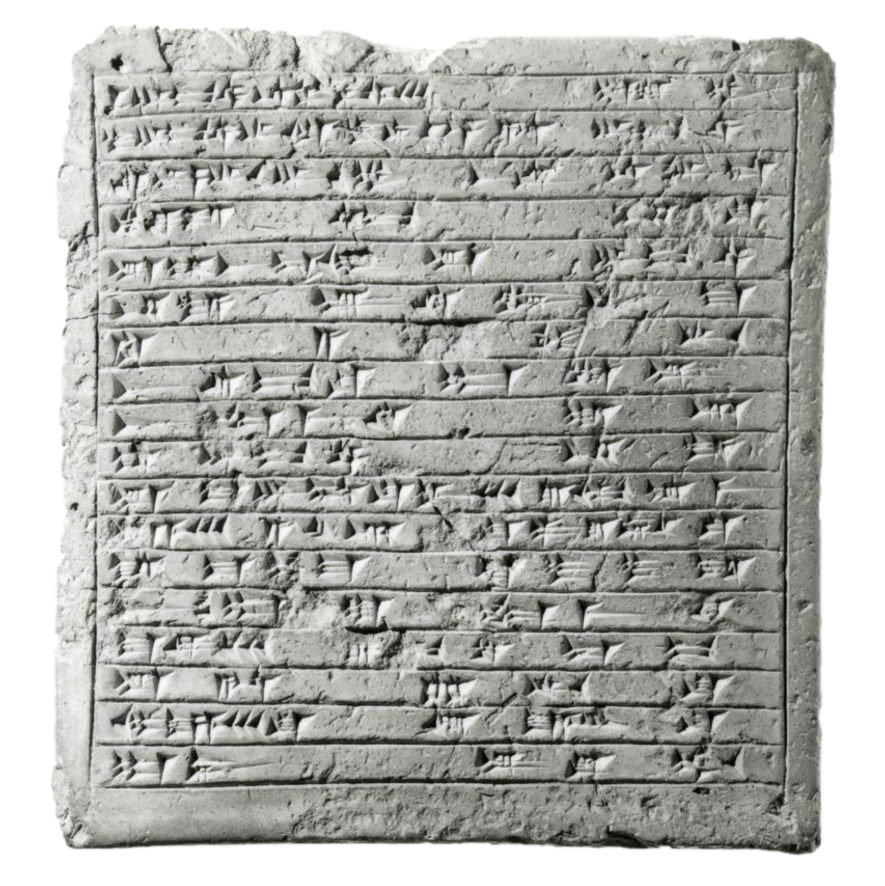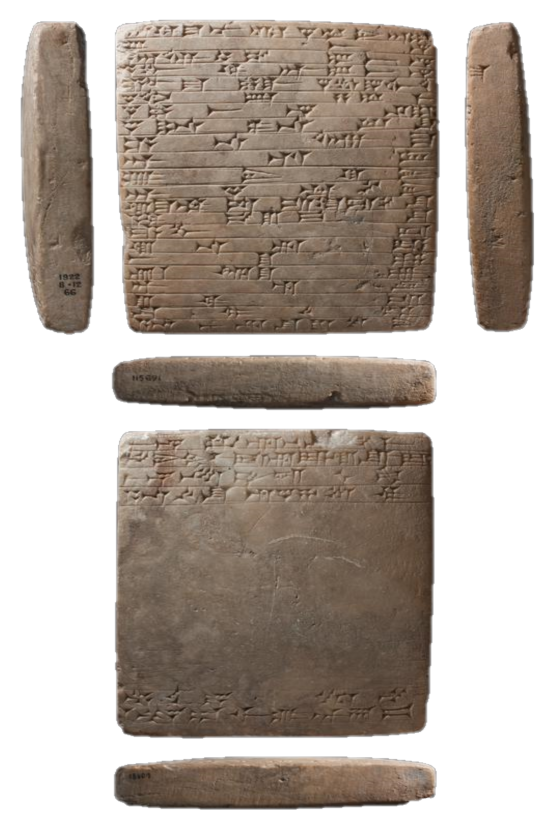THE ASSYRIANS
The Assyrians are a Semitic people which settled in the northern part of Mesopotamia in the third millennium B.C. The earliest inhabitants of Assur were subject to the Akkadian Empire and again to the kings of the Third Dynasty of Ur. After the eclipse of the Third Dynasty of Ur a line of Assyrian Kings held the throne successively in an independent sovereign Old Assyrian Kingdom. At that time the power of Babylon was on the up-swing and Hammurabi, who succeeded in overwhelming and destroying his rivals one by one, also gained control over Assyria. The ensuing thousand years was full of oscillating tensions, with attacks and counterattacks between the south and th north. At one time the south seized control of Assyria and at another the latter penetrated deep into the south.
The Assyrians recorded the names and reigns of their kings. At the site of Khorsa bad were found copies of the Assyrian King List which date from the time of Sargon (ca. 722-705 B.C.) and begin with the earliest rulers down to the reign of Sargon Since the history of Assyria is one which is long and eventful, scholars have divided it into the following periods:
Old Assyrian Period
The Old Assyrian Period begins with the earliest phase of Assyrian history and car ries through to the eclipse of the First Babylonian Dynasty. There is no evidence that Assur possessed any political structure during the third millennium B.C. but it was pro- bably under direct Sumerian influence. The great Assyrian King List which mentions the names of the first seventeen monarchs’ states that these kings lived in tents’, i.e. led a nomadic life. Under Akkadian suzerainty the people of Assur cooperated in orga- nizing overland trade and in spreading Mesopotamian civilization throughout the northern plains. In the Gutian period, several Assyrian monarchs may have achieved local do minance, such as Kikia, who erected Assur’s fortification walls, and Ushpia, who built at Assur a temple for the God Assur. The names of such early monarchs are neither Semitic nor Sumerian but are possibly of Subarian origin, an ethnic stratum which inhabited northeastern Mesopotamia and with whom the Assyrians intermingled. Then, under the Third Dynasty of Ur, the Assyrians again fell under Sumerian influence. The Assyrian vassal king Zariqum is known to have been contemporaneous with Amar-Sin, king of Ur (ca. 2045-2037 B.C.). After the fall of the Ur III empire, Assur regained its independence; and during the reign of its independence, and during the reign of its king Ilu-shuma, a contemporary of the founder of the First Dynasty of Babylon (Who must have reigned about 1894-1881 B.C.), it appears as a political and military power and is known to have raided deep into southern Mesopotamia. In the time of Shamash Adad (Samsi-Addu! 1815-1782 B.C.) the Old Assyrian Kingdom reached an unprecedented supremacy. He led its armies to domination over most of the cities in central Iraq and the Euphrates area, in particular Mari (modern Tell Hariri). But towards the end of Shamshi-Adad’s reign, Hammurabi, King of Babylon, turned his ambitions towards the north and with the death of the Assyrian King, the Assyrians were forced to accept Babylonian rule. Assur, capital city of the Old Assyrian Period, is situated on a bluff on the west bank of the Tigris, about 110 kilometers south of Mosul. This, the oldest and most sacred of Assyrian cities, was thoroughly excavated by a German Expedition (Deutsche Orient-Gesellschaft) for twelve consecutive years from the beginning of the present century. The excavators exposed its town plan with its temples, palaces and gates, and graves of the Assyrian kings, and found an incomparable wealth of objects from the Sumerian. Akkadian and Assyrian Periods.3
Middle Assyrian Period(1365-912 B.C.)
The Middle Assyrian Period begins at about the time of the fall of the First Babylonian Kingdom and carries on through the Kassite rule in Babylon until the Beginning of the ninth century B.C. After Hammurabi died, Assyria remained under the Babylon.
ian shadow until Babylon fell to the Hittites in the sixteenth century B.C. The Hittites. Having plundered the city, took its treasures and retreated to their uplands, and the Kassites, seizing the opportunity offered by the Hittite withdrawal, occupied Babylon and founded the Kassite Dynasty (on which see above). In the north, the kings of Assur gradually managed to assert Assyrian independence in the face of the Aramaean invasions from the west. In Northern Mesopotamia the Assyrians had to overcome the powerful Mitannian kings, vassals of whom ruled in the Kirkuk area, over a kingdom composed of the mountain Hurrian population and from Anatolia the Hittite Empire exercised control over the Upper Euphrates and Khabur Rivers, quite apart from the aggressive ambitions of the Kassites towards the north. After centuries of political confusion and bitter conflict, Assyria won its position as a sovereign, independent nation. The Middle Assyrian Empire was effectively established under Assur-uballit.
Assur-uballit (1365-1330 B.C.), was the first king in the Middle Assyrian period to give Assyria the right to be called a significant power. He extended his domination to include the Mitanni Kingdom which he subdued in the mid-fourteenth century B.C. He engaged in friendly relations with the Hittites and with the Egyptian Pharaoh Amenophis IV (Akhnaton) and exercised influence over Babylon, whose Kassite king took his daughter in marriage.

tablet commemorating the construction of a private house, with its own well, near the Marduk temple at Ashur; the author Marduk-nadin-ahhe, describes himself as the royal scribe of the Assyrian king Ashur-uballit. Findspot Kalah Shergat (Ashur) iraq
Shalmaneser I (1274-1245 B.C.), was the greatest warrior of the dynasty. During his
reign the Assyrian Kingdom expanded into the mountains in the east and to west and south. His name is associated with the foundation of new city Calah (Kalhu), modern Nimrud, 35 kilometers south of Mosul.

Stone stela of Shalmaneser I: a foundation record containing a 22-line ruled cuneiform inscription across the face. Excavated by: Walter Andrae Findspot: Ashur iraq
- Inscription language: Akkadian
- Inscription translation: I cleared away its debris, reconstructed the weakened portions, and rebuilt the ruined section from top to bottom. I deposited my stelas. May a later prince restore the dilapidated gate and return my inscribed name to its place.
- Inscription note: Describes how Shalmaneser I rebuilt one of the gateways at Ashur. The inscription gives the month in which it was written, and the name of the official after whom the year was named, but exactly which year this was is not known.
Shalmaneser I was succeeded by his son:
Tukulti-Ninurta I (1115-1208 B.C.) who fought the Kassites and occupied Babylon, later, however, an internal revolt took place in Assyria in which he died ignominiously. A period of confusion and weakness then followed. Towards the middle of the twelfth century B.C., the Elamites dealt the great blow to Babylon which resulted in the end to the Kassite Dynasty, Weakness and confusion was also felt in Assyria, although some skirmishes and small-scale incidents occurred between the Assyrians and Babylonian during the reign of Nebuchadnezzar I.

Limestone memorial stele or tablet of Tukulti-Ninurta I, King of Assyria; inscribed with roughly thirty-three lines of cuneiform text on one side and twenty-three lines of the text on the other side, both recording his titles and genealogy and describing briefly his numerous campaigns; there is also a reference to his building of Kar Tukulti-Ninurta
After that an energetic Assyrian King, Tiglathpileser I came to power.
Tiglathpileser I (1157-1077 B.C.) was a powerful king who played a great part inleading Assyria to a new era of prominence. He expanded the eastern and northern frontiers, going up to the “lands of Nairi”, penetrated deep into Armenia and reached Lake Van. He then directed his attention to the west and marched to the Phoenician seaboard where security was already threatened by the movements of the ‘Sea-Peoples Finally he struck south and occupied “Kar-Duniash” or Babylonia (1100 B.C.). The far-flung Assyrian domain shadowed the entire Near East from the Arabian Gulf to the Mediterranean costs, and the cultural and political development of this period is illuminated by the historical and other inscriptions from the reign of this king.By the death of this great king, the zenith of the Middle Assyrian Period was passed. His successors most of his territorial acquisitions were lost and the kingdom once more fell back into a time of decadence. The mounting invasions of Aramaean tribes towards the east during the eleventh and tenth centuries B.C., and the obstacle the posed to any possible advance westwards by the Assyrians, constituted a principal cause of Assyrian weakness. The Aramaeans consolidated their power along the western borders of Assyria and in small kingdoms Syria. The dark age of Assyria continued untilthe advent of a new line of powerful and determined Assyrian rulers who consolidated the structure of the state and founded a new and effective army which brought them success in their campaigns.

Clay prism with historical inscription of Tiglath-pileser I, recalls civil and military achievements including campaigns against the Muski and Kumuh, the conquest of Carchemish, his hunting expeditions and building activities in Ashur and other cities and repair to the temple of Anu and Adad founded by Samsi Adad I in about 1725 BC
Faraj Basmachi + Harvard University + British Museum + Iraq Museum + Louvre Museum + University of Chicago


